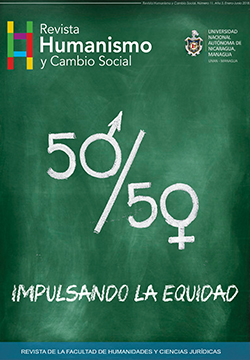Conception of Desirable Life of the Indigenous Peoples of the Pacific, Central and Northern Nicaragua
DOI:
https://doi.org/10.5377/hcs.v0i11.8735Keywords:
Good Living, Nicaragua, indigenous peoples, land, identity, equity, sustainabilityAbstract
This paper proposes that the indigenous peoples of Nicaragua continue to practice a model of community coexistence that allows them to maintain a way of life in harmony with themselves, with others and with nature. The essential contribution of the work lies in positioning in the academic field the different conceptions of the good living (living beautifully) of the indigenous peoples of Nicaragua. The objective of the study is to unravel the conception of the good life of the peoples settled in the zone of the Pacific, Center and North of Nicaragua ((nahoa, sutiaba, chorotega and matagalpa) by asking: Does the good life of the indigenous peoples of the Pacific, Central and Northern regions of Nicaragua exist, where the survival of 22 indigenous peoples of Nahoa, Sutiaba, Matagalpa, and Chorotega descent is acknowledged? To carry out the study, four communities were selected. These communities were considered to be the most representative of the ethnic groups studied, taking into account their higher relative level of isolation, their lower degree of acculturation and the survival of their customs and traditional ways of life, so that the studies carried out could show the survival (or not) of a good ancestral life in the current daily life of these indigenous peoples: for the Nahoa people the rural community of Urbaite - Las Pilas, for the Sutiaba people the rural community of Troilo, The objective of the study is to unravel the conception of the good life of the peoples settled in the zone of the Pacific, Center and North of Nicaragua ((nahoa, sutiaba, chorotega and matagalpa) by asking: Does the good life of the indigenous peoples of the Pacific, Central and Northern regions of Nicaragua exist, where the survival of 22 indigenous peoples of Nahoa, Sutiaba, Matagalpa, and Chorotega descent is acknowledged? To carry out the study, four communities were selected. These communities were considered to be the most representative of the ethnic groups studied, taking into account their higher relative level of isolation, their lower degree of acculturation and the survival of their customs and traditional ways of life, so that the studies carried out could show the survival (or not) of a good ancestral life in the current daily life of these indigenous peoples: for the Nahoa people the rural community of Urbaite - Las Pilas, for the Sutiaba people the rural community of Troilo.
Downloads
References
Arrellano, J. E. (2003). Sutiaba: Alter Ego de León y su mito del cacique Adiac. La Prensa, 9 de noviembre de 2003.
Asamblea Nacional (2014). Constitución Política de Nicaragua y reformas. Managua: Asamblea Nacional.
Cruz Barrios, C. et al. (2017). El Buen Vivir Nahoa, en la comunidad Urbaite las Pilas, (Isla de Ometepe), mimeo. Managua y Huelva: Proyecto FIUNANMUHU, UNAN - Managua y Universidad de Huelva
Cubillo-Guevara, A. P., Hidalgo-Capitán, A. L. y García-Álvarez, S. (2016). El buen vivir como alternativa al desarrollo para América Latina. Revista Iberoamericana de Estudios del Desarrollo, 30-57.
Delgado S. et al. (2017). El Buen Vivir Sutiaba, en la comunidad de Troilo (León), mimeo. Managua y Huelva: Proyecto FIUNANMUHU, UNAN - Managua y Universidad de Huelva.
Secretaría Nacional de Planificación y Desarrollo. (2014). La felicidad como medida del Buen Vivir en Ecuador. Entre la materialidad y la subjetividad. Quito, Ecuador.
Unceta, K. (2014). Desarrollo, postcrecimiento y Buen Vivir: Debates e interrogantes. Quito-Ecuador: Ediciones Abya-Yala.
Villalta Orozco, M. et al. (2017a). El Buen Vivir Chorotega en la comunidad de El Cuyal. (Mozonte), mimeo. Managua y Huelva: Proyecto FIUNANMUHU, UNAN - Managua y Universidad de Huelva.
Villalta Orozco, M. et al. (2017b). El Buen Vivir Matagalpa, en la comunidad Yucul, (San Ramón), mimeo. Managua y Huelva: Proyecto FIUNANMUHU, UNAN - Managua y Universidad de Huelva.
Gutiérrez Gómez, W. A.(2015). Wilmer Antonio Gutiérrez Gómez. Etnia Chorotega, Soltero, 36 años Expresidente del PICTACH, Abogado. Entrevista realizada por Marvin Villalta, en Totogalpa Madriz.
Mairena Ruiz,R. (2015). Rigoberto Mairena Ruiz. Etnia Matagalpa. 55 años. Soltero. Asesor de Pueblos indígenas, abogado. Entrevista realizada por Marvin Villalta, en Matagalpa.
Rivera, L. M.(2015). Luz Marina Rivera. Etnia Chorotega. 48 años, Soltera. Asesora jurídica del Pueblo indígena Chorotega de Mosonte. Entrevista realizada por Marvin Villalta, en Mozonte. artículos Lic. Carlos Lenys Cruz Barrios. 68
Mendoza. R (2015). Rigoberto Mendoza. Etnia Sutiaba. 60 años. Miembro del Pueblo indígena de Sutiaba. Entrevista realizada por Salomón Delgado, en León.
Delgado S, O. (2015). Osman Delgado Salinas. Etnia Sutiaba. 63 años. Miembro del Pueblo indígena de Sutiaba. Entrevista realizada por Salomón Delgado, en León
Barrios, L. (2016). Lilliam Barrios. Etnia Nahoa, 45 años, Soltera, miembro del pueblo indígena Naha, Entrevista realizada por Carlos Lenys Cruz B, en Isla de Ometepe.
Hernández, V. (2016). Victoria Hernández. Etnia Matagalpa, 60 años, casada, miembro del pueblo indígena Matagalpa, Entrevista realizada por Marvin Villalta, Yucul, Matagalpa.
Soza, C. (2016). Crescencio Soza. Etnia Matagalpa, 58 años, casado, miembro del pueblo indígena Matagalpa, Entrevista realizada por Marvin Villalta, Yucul, Matagalpa.




